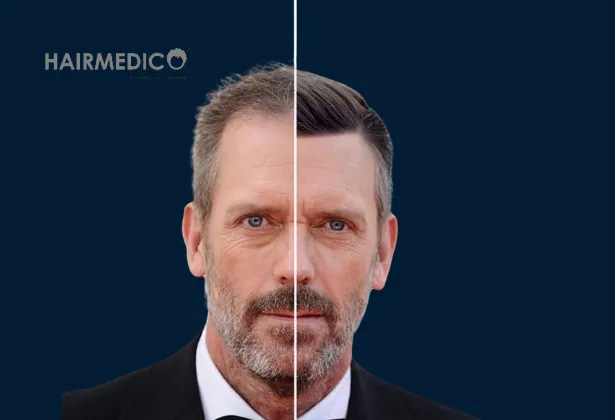
Hugh Laurie, the British actor known for his role as Dr. Gregory House in House M.D., has always been admired for his distinct appearance. Over the years, noticeable changes in his hairline have fueled speculation about whether he has undergone a hair transplant or other hair restoration procedures.
This article will explore:
If you are considering a permanent solution for hair loss, learn more about FUE and DHI hair transplant techniques and how they can restore natural hair density.
Hugh Laurie has never publicly confirmed having undergone a hair transplant, but changes in his hairline suggest he may have undergone some form of hair restoration treatment.
During his earlier career, Laurie had thick, wavy hair, which later showed signs of thinning and recession. However, in recent years, his hair appears fuller and healthier, leading to speculation about potential medical interventions.
While natural variations in hair density are possible, the improvement in his hairline strongly suggests the use of advanced restoration techniques.
Follicular Unit Extraction (FUE) is the most advanced and minimally invasive technique for restoring a receding hairline. This procedure involves extracting individual hair follicles from a donor area (typically the back of the scalp) and implanting them into thinning areas.
If you’re considering a similar procedure, learn more about FUE hair transplants and their long-term benefits.
Platelet-Rich Plasma (PRP) therapy and Exosome therapy are regenerative treatments designed to stimulate hair growth and strengthen existing follicles.
These treatments are often combined with hair transplants to enhance results and accelerate recovery. Learn more about PRP therapy for hair restoration.
Some celebrities maintain hair density using medications like Finasteride and Minoxidil, which are clinically proven to slow hair loss and encourage regrowth. Additionally, cosmetic enhancements like hair fibers can create the appearance of thicker hair.
While these methods can improve overall hair appearance, they do not offer the permanent results of a hair transplant. If Hugh Laurie’s transformation was non-surgical, he likely followed a combination of PRP, Finasteride, and Minoxidil.
For more information about hair restoration solutions, visit Hairmedico.
Dr. Arslan Musbeh, a leading hair transplant expert at Hairmedico, weighs in on Hugh Laurie’s hair transformation:
"Based on photographic comparisons, Hugh Laurie's hairline shows signs of increased density and structure, which are typical of an FUE hair transplant. While PRP and medications can improve hair health, the level of transformation suggests a surgical approach."
For a personalized hair restoration consultation, book an appointment with Hairmedico today.
While Hugh Laurie has not confirmed undergoing a hair transplant, noticeable improvements in hairline density suggest he may have benefited from FUE, PRP therapy, or a combination of treatments.
If you are looking for a permanent solution to hair loss, explore modern hair restoration techniques with a trusted expert.
For a consultation with Dr. Arslan Musbeh, visit Hairmedico today.